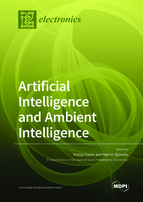Artificial Intelligence and Ambient Intelligence
A special issue of Electronics (ISSN 2079-9292). This special issue belongs to the section "Artificial Intelligence Circuits and Systems (AICAS)".
Deadline for manuscript submissions: closed (31 March 2021) | Viewed by 30509
Special Issue Editors
Interests: intelligent systems; artificial intelligence; machine learning; intelligent agents; multiple knowledge representations; assistive technologies
Special Issues, Collections and Topics in MDPI journals
Special Issue Information
Dear Colleagues,
Ambient intelligence (AmI) and artificial intelligence (AI) both rely on AI methods applied to computing devices. Furthermore, their power stems from the same advancement of electronics, sensors, and software development. Yet, AmI is not just an AI application serving humans, and by its definition it is even more aligned to interactions with humans. Be it smart home or autonomous car, it is essential for the AmI system to be familiar with the user’s desired performance as well as the current state of the mind. As such, the human-system relation is of a predominant importance, and it represents one of the most fruitful, but often neglected fields of research for AI.
Strategically, the hardware (HW) and software (SW) exponential development was essential not only for AI and AmI, but for the overall human civilization as well. Information society laws such as Moore’s Law or Keck’s Law describe the progress of electronic computing and data transfer and storage devices. While several limitations of specific HW characteristics (e.g., the speed of the processor chip) have already been met, it is not clear which are the next promising technology fields to enable further HW progress. Is it that we are facing a slow but steady decline following the fast exponential growth? Are there major possibilities of improvements by connecting SW, AI, and AmI methods directly to the chips? Should we integrate the flexibility of SW with the speed of electronic HW and vastly improve the cognitive and computing powers? Will AmI benefit more through this progress, since is it intrinsically devoted to connecting devices and humans? Which one will bring the most benefit to the human society and which one will first achieve superintelligence – general AI or general AmI?
Answers to these and related questions represent the core of this Special Issue. In order to cope with the abovementioned obstacles, original studies and either viewpoints, theoretical analyses or modeling methods can be developed and proposed to foster further progress.
Specific Topics
We invite researchers to contribute original research articles as well as review articles to present their proposals, views, and studies in the field of AmI and AI in relation to the overall HW, SW, and human civilization progress. Submissions can focus on the research concept or applied research in topics including, but not limited to, the following:
- Applications in COVID-19: patient monitoring, patient rehabilitation, brain-computer interfaces,assisted living and caring, fall detection, elderly care,interventions for psychological crises
- Applications in smart homes and smart buildings
- Mobile/wearable intelligence
- Robotics applied to smart environments
- Applications of combined pervasive / ubiquitous computing with AI
- Use of mobile, wireless, visual, and multi-modal sensor networks in intelligent systems
- Intelligent handling of privacy, security and trust
Prof. Dr. Matjaz Gams
Dr. Martin Gjoreski
Guest Editors
Manuscript Submission Information
Manuscripts should be submitted online at www.mdpi.com by registering and logging in to this website. Once you are registered, click here to go to the submission form. Manuscripts can be submitted until the deadline. All submissions that pass pre-check are peer-reviewed. Accepted papers will be published continuously in the journal (as soon as accepted) and will be listed together on the special issue website. Research articles, review articles as well as short communications are invited. For planned papers, a title and short abstract (about 100 words) can be sent to the Editorial Office for announcement on this website.
Submitted manuscripts should not have been published previously, nor be under consideration for publication elsewhere (except conference proceedings papers). All manuscripts are thoroughly refereed through a single-blind peer-review process. A guide for authors and other relevant information for submission of manuscripts is available on the Instructions for Authors page. Electronics is an international peer-reviewed open access semimonthly journal published by MDPI.
Please visit the Instructions for Authors page before submitting a manuscript. The Article Processing Charge (APC) for publication in this open access journal is 2400 CHF (Swiss Francs). Submitted papers should be well formatted and use good English. Authors may use MDPI's English editing service prior to publication or during author revisions.
Keywords
- Ambient intelligence
- Artificial intelligence
- Superintelligence
- Multi-agent systems
- Ambient assisted living
- Computational intelligence methods
- Pervasive Computing
- Mobile computing
- Ubiquitous computing
- Self-adaptation, self-organisation, and self-supervised learning
- Intelligent interfaces (user-friendly man–machine interface)
- AI-assisted medical diagnosis
- Mobile sensing applications
- Autonomous and social robots
- IoT and cyber-physical systems







